Por favor, use este identificador para citar o enlazar a este item:
http://hdl.handle.net/10261/124926COMPARTIR / EXPORTAR:
 SHARE SHARE
 CORE
BASE CORE
BASE
|
|
| Visualizar otros formatos: MARC | Dublin Core | RDF | ORE | MODS | METS | DIDL | DATACITE | |

| Título: | Low-dose curcumin stimulates proliferation, migration and phagocytic activity of olfactory ensheathing cells |
Autor: | Tello Velasquez, Johana; Watts, Michelle E.; Todorovic, Michael; Nazareth, Lynmaría; Pastrana, Erika; Díaz-Nido, Javier CSIC ORCID; Lim, Filip CSIC ORCID; Ekberg, Jenny A. K.; Quinn, Ronald J.; St John, Jamas A. | Fecha de publicación: | 31-oct-2014 | Editor: | Public Library of Science | Citación: | PLoS ONE 9 (2014) | Resumen: | © 2014 Tello Velasquez et al. One of the promising strategies for neural repair therapies is the transplantation of olfactory ensheathing cells (OECs) which are the glial cells of the olfactory system. We evaluated the effects of curcumin on the behaviour of mouse OECs to determine if it could be of use to further enhance the therapeutic potential of OECs. Curcumin, a natural polyphenol compound found in the spice turmeric, is known for its anti-cancer properties at doses over 10 μM, and often at 50 μM, and it exerts its effects on cancer cells in part by activation of MAP kinases. In contrast, we found that low-dose curcumin (0.5 μM) applied to OECs strikingly modulated the dynamic morphology, increased the rate of migration by up to 4-fold, and promoted significant proliferation of the OECs. Most dramatically, low-dose curcumin stimulated a 10-fold increase in the phagocytic activity of OECs. All of these potently stimulated behavioural characteristics of OECs are favourable for neural repair therapies. Importantly, low-dose curcumin gave a transient activation of p38 kinases, which is in contrast to the high dose curcumin effects on cancer cells in which these MAP kinases tend to undergo prolonged activation. Low-dose curcumin mediated effects on OECs demonstrate cell-type specific stimulation of p38 and ERK kinases. These results constitute the first evidence that low-dose curcumin can modulate the behaviour of olfactory glia into a phenotype potentially more favourable for neural repair and thereby improve the therapeutic use of OECs for neural repair therapies. | URI: | http://hdl.handle.net/10261/124926 | DOI: | 10.1371/journal.pone.0111787 | Identificadores: | doi: 10.1371/journal.pone.0111787 issn: 1932-6203 |
| Aparece en las colecciones: | (CBM) Artículos |
Ficheros en este ítem:
| Fichero | Descripción | Tamaño | Formato | |
|---|---|---|---|---|
| StJohn_Low-DoseCurcumin.pdf | 14,48 MB | Adobe PDF |  Visualizar/Abrir |
CORE Recommender
PubMed Central
Citations
27
checked on 10-abr-2024
SCOPUSTM
Citations
56
checked on 15-abr-2024
WEB OF SCIENCETM
Citations
50
checked on 28-feb-2024
Page view(s)
312
checked on 15-abr-2024
Download(s)
208
checked on 15-abr-2024
Google ScholarTM
Check
Altmetric
Altmetric
Artículos relacionados:
NOTA: Los ítems de Digital.CSIC están protegidos por copyright, con todos los derechos reservados, a menos que se indique lo contrario.
